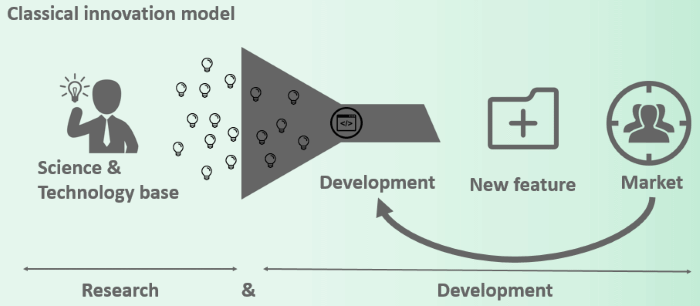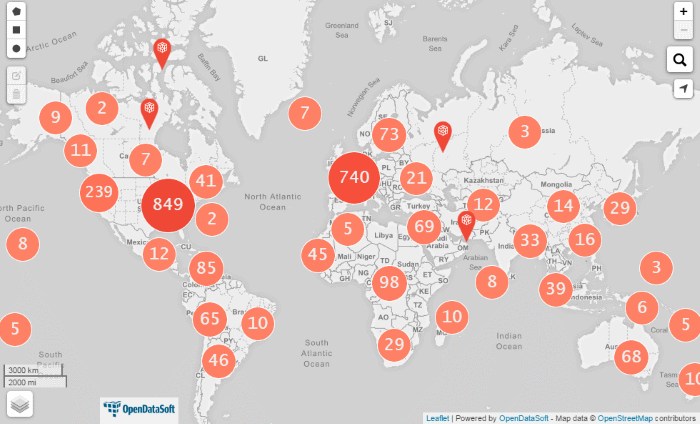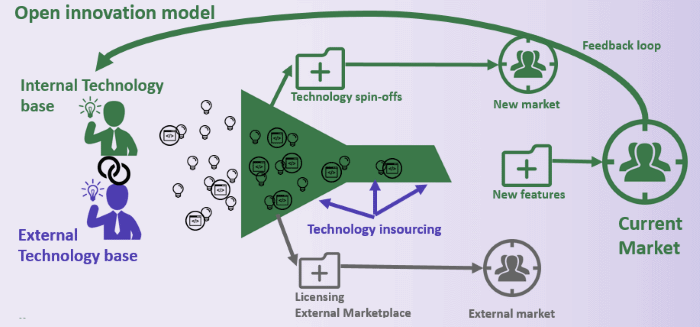Why do some business opt for open innovation, giving away some of their knowledge without expecting anything in return (at first sight, at least)? What do they actually have to gain from this strategy?

Firstly, let us remember that “innovate” comes from the Latin innovare (in: internal, novare: change) and thus carries with it the idea of renewal and return. Innovation is therefore a two-faced concept, since it is very much turned in towards the system which itself wishes to change, in a somewhat self-centred way. However innovation should only be conceived within a broader system as it feeds on and is inspired by ideas and discoveries from other systems which are being renewed.
Business can innovate on many fronts:
- Products, services and experience
- Performance and presentation
- Procedures and processes
- Measures and decisions
- Organisation and practice
- Information technologies and systems
- Security and regulation
- In short, the business’s entire value chain can undergo such a “renewal”.
Innovation is based on an R&D model
Traditionally, innovation in business is based on a research and development model which can be segmented (product R&D, IT R&D, etc.) or centralised (innovation division). So, with the bodies in charge of innovation having the objective of proposing ideas on the basis of the state of the art in the market, generally viewed through the lens of “basic research”. These ideas are tested via internal development, some are discarded as impracticable (for financial, regulatory, human resources or other reasons).
Validated developments may then sometimes lead to a new product or a new functionality. This new product or new functionality can then finally be put on the market. Setbacks are expensive, successes take time. Introduction to the market is the crucial stage in the rejection/acceptance of an innovation, often taken over by the marketing and commercial arms of the business.
For the more battle-hardened in terms of development, investment will be made in work on market introduction quite early in the lifecycle of the innovation in order to maximise the chances of successfully meshing with a market and thus of generating a profit. The limit is that only the finished product is considered as viable and only the vision of those in sales is a vector for growth.

A lack of openness to the outside
The great weakness of this system very clearly lies in its lack of openness to the outside and of bilateral exchange. Traditional innovation will concentrate on IP and produce the innovations internally without revealing anything to the outside world, drawing little from external sources in order to control risks, stay in control of innovation and rationalise the approach. The famous myth of industrial espionage and the retention of knowledge still has its fervent followers.
After a number of years this major weakness is being transformed by a growing awareness and thus a paradigm shift which is in the process of revolutionising the practices surrounding innovation. So why do some companies open up their source code? Why do they give away their knowledge while expecting nothing in return (in the first instance)?
Today, collaboration and openness are powerful tools for building visibility, reputation, dialogue, acceleration and profit. This openness is of course not complete, it is controlled, carefully eked out to allow the “open enterprise” to pick a path among big businesses without their having understood why or how.
The five levers to boost innovation
In our existing economy, the main levers that allow innovation in the practice of innovation itself are:
1. The spread of the internet
The internet has wrought deep changes to our society and our economy, and has now become a key element in both. We consider that here too its contribution will lead to profound changes in our way of life, in particular faced with the great environmental and economic crisis through which we are living. Internet technology, as a vector for networked sharing should become a model for innovation, particularly in terms of energy management. Many projects have given this aspect major leverage in the third industrial revolution and the advent of lateral power.
2. Collaborative economies
Aware of these forces, this trend towards exchange and convergence, rather than silos and parallelisation, some businesses have made this development the spearhead of their business model. We have noted the emergence of companies with very limited assets but for whom their community and its role in their economic model is crucial. Uber for example has no cars or drivers of its own, strictly speaking. It is instead a collaboration between users which is the primary asset of the business and explains the success of its economic model.
3. Open source
Open source has definitively earned its spurs and has become a serious, even unavoidable, option for businesses. Many open source projects have become established as in heavyweights in their field, such as those of the Apache foundation or the many community projects on Git.
A wide range of open source tools are available today, increasingly becoming the reference in their fields. For example, we could cite R for scientific data, the big data stack (hadoop, spark, kafka, cassandra, couchbase, Hive, ELK, etc.), many CMSs and e-commerce systems, many free development languages such as java and python, and much more. Almost every field is covered by a larger or smaller stack of free or pseudo-free tools.
4. Open data
Data is the black gold of the 21st century, and sharing it is the paragon of what innovation can contribute in terms of added value. This is no longer the time for data retention at any price, but rather for openness, sharing and exchange while respecting the law, which is becoming increasingly vigilant when it comes to personal data protection. Many open data portals exist, opening up an enormous field for future work. You can also see the trend of businesses to share their data within the peer to peer exchange arrangements more familiarly known as 2nd party data, which is a form of open data.

5. Open APIs
In parallel with open data, open APIs open access to proprietary applications, the data they hold, the services they host and the methods that control them up to businesses and developers. Open APIs make public the methods and the controls over data exchange between applications, obviating the need to program some functionalities but instead capitalising on tested existing code to achieve software excellence. Among the best known candidates we could mention the open APIs of Facebook, Twitter, tour operators’ sites, the main online media, and OpenAPI (a project on GitHub, fka The swagger.
Great power = great responsibility
As Uncle Ben said, “with great power there must also come – great responsibility!” With these levers there come a large number of profound changes to the business, not least in terms of the culture and methodology of project management, implementation and the sharing of work. The new obsessions are without doubt speed, flexibility, quality, measurement and added value for the user. Agile and lean approaches are well known today but still too rarely used, and rarely as intended. They have become prerequisites for moving into open innovation.
Business must relearn to reappropriate the new models of innovation in an economy in transformation.

There is a wide range of sources of innovation and internal and external must be mixed. The sourcing of external ideas and practices takes place at every stage of development. Intermediary products that come out of this collaborative innovation can give rise to new products or functionalities that strengthen or renew the portfolio of the brand but can also be sources of development on of new markets or totally external markets via intermediaries or partnerships.
It therefore seems important for businesses to be able to position themselves within this new paradigm.
Open innovation: how far have you got?
When it comes to open innovation, there are a few different business profiles. Which do you fit into?

Early birds
Early birds/adopters in search of disruption as part of their strategy and their economic model. This is where you will find the most innovative, those who test, who learn, who “fail fast”, who set the tempo!

Flock / Majority
Adopts once the market has become structured and the risks have decreased. A distinction can be drawn between “early majority” and “late majority”. Here we find the next in line, who have a fairly opportunistic, if measured, view on innovation.

Night Owls / Laggards
Always late on the market as a result of excessively rigidity in their decision making processes and innovation policy; this profile is often linked with the enterprise culture and a traditional average or large business where decision-making has become sclerotic.
As with any issue involving a substantial change management aspect and organisational changes, it is not actually a question of knowing whether the business has to accept these new codes, plan for them and adapt to them, or yet of knowing whether it has the capacities, but rather of knowing when it is going to harness them and how it is going to handle the subject as an opportunity with pragmatism and creativity.
In human resources, they always say:
Manager: “But what do we do if we train up our staff and then they leave?”
HR: “What do we do if we don’t train them up and they stay?”
I would look the same way at businesses adopting open innovation: what will you do if you don’t go open and your innovation stays the way it is?
















Your email address is only used by Business & Decision, the controller, to process your request and to send any Business & Decision communication related to your request only. Learn more about managing your data and your rights.